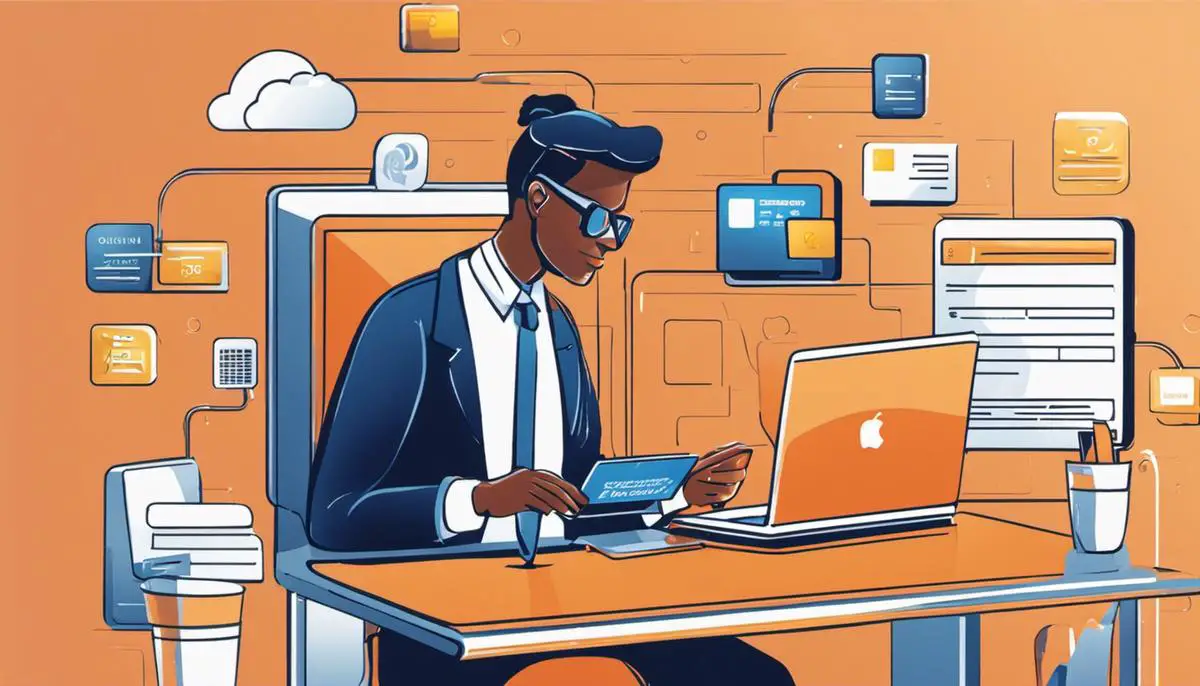Navigating the world of online transactions can be daunting, especially when problems arise. It becomes more challenging when you encounter problems with your credit card login which is an important aspect of digital commerce.
This credit card login troubleshooting guide aims to demystify the structure of online credit card systems and their login processes, provide a comprehensive knowledge of common errors that users might encounter, and detail feasible troubleshooting steps. It will take you on a journey to familiarize with the website and mobile app platforms of different credit card companies, understand the differences in handling login issues across these companies, and learn to apply simple to more complex solutions independently.

Understanding Credit Card Online Systems
Credit card online systems are fundamentally designed for user’s easy access to their account. They generally require inputting of certain information such as usernames and passwords, establishing connection with the bank’s server to verify the data and then granting access to the account. Most of these systems also have security protocols to ensure that the data exchange is safe and private. This is commonly done by encrypting the information entered by the user.
Usernames & Account Passwords
For you to successfully login into your credit card online system, you will need your username, which can either be a custom name you set upon creating the account or your credit card number. Next, you need your password, which is sensitive to capitalization. Be sure to remember how you’ve input it.
Once you input these details and hit enter, the system verifies these details with the banks’ server to validate the entered data aligns with the records. If the entered data matches the records of the bank, you’re granted access to your account.
The most common error in credit card online systems is an incorrect password or username. Due to the case sensitivity of passwords, even a single capitalized letter where it should not result in a user being denied access. Also, if a user, after several failed attempts, continues to enter wrong credentials, the account might be temporarily locked as a security measure.
Strong Internet Connection is Necessary for Successful Login
Users sometimes report issues with logging in due to poor internet connections. In most cases, the data entered cannot be correctly verified with the bank’s server if the connection is poor or inconsistent. Similarly, technical glitches either from the bank’s server or on the user’s device may also cause login inefficiencies.
For password and username related issues, verify that the data you entered is correct. Double-check for correct capitalization, the absence of unneeded spaces, and the correct sequence of numbers and letters. If you’re experiencing persistent issues, you might want to reset your password through the provided link on the login page. Be sure to have access to your registered email for this.

In the event of poor internet connection, try connecting to stronger networks or consider moving to a location with improved connectivity. If you suspect that technical glitches could be responsible, a device restart could potentially solve this problem.
Typically, credit card banks offer both website and mobile app options for accessing and monitoring your account. Both platforms adopt a similar login process. The key difference is mobile applications are more likely to offer biometric (fingerprint or facial recognition) security measures for logging in.
For trouble with mobile apps, updating to the latest version can often solve the problem. But, if the issue persists, uninstalling and reinstalling the app may be necessary.
Knowledge of these aspects of credit card online systems can help you fix credit card login issues.

Detailed Credit Card Login Troubleshooting Steps
Check Your Internet Connection
When dealing with credit card login issues, it’s important to ensure that you have a stable internet connection. A key step in this credit card login troubleshooting guide is your internet connection. If the page is taking too long to load or does not load at all, it’s possible that your internet connection is at fault. Check the connection status on your device and try to load a different website to confirm if it’s an issue with your internet. If there’s an issue with your internet, try resetting your router or switch to a different network if possible.
Recheck Your Login Credentials
After ensuring your network connection is not the problem, the next step is to recheck your credit card login details. Ensure that you are inputting the right username and password. Note that most passwords are case sensitive, so make sure the Caps Lock key is not engaged. If you can’t remember your login details, you may need to reset them.
Resetting Your Password
In most cases, credit card companies will have a “Forgot Password” or “Reset Password” option on the login page. Select this option and follow the instructions provided. This usually involves verifying your identity through a secondary email, phone number, or security questions. You will then be able to set a new password.
Verify Your Account Information
If the above steps do not resolve the issue, you may need to verify your account information. Ensure that your credit card number, expiry date, and security code have been entered correctly. If any of these information is incorrect or out-of-date, your login attempt may be unsuccessful.
Check Your Account Status
Sometimes, a login problem can be due to an issue with your credit card account itself. Ensure your account is not frozen, suspended, or closed. In these cases, you may have to contact the card issuer’s customer support for credit card login issues for help.
Variations With Different Credit Card Companies
Different credit card companies may have slightly differing procedures for resolving login issues. Some may have additional security measures like two-factor authentication, which requires a second verification step. If you’re experiencing difficulty, refer to the specific company’s troubleshooting guide or customer support resources. Most credit card companies have this information available on their website, or you can contact them directly through phone or email.
Update or Change Your Web Browser
Lastly, if none of the above steps work, the issue may lie with the web browser you are using. Some websites do not function well with certain browsers. Try using a different browser to login or update your current browser to the latest version. Clearing your browser’s cache and cookies could also help solve the issue.

Security and Fraud Prevention
Understanding Two-Step Verification
Two-step verification, also known as multi-factor authentication, is a security measure that many financial institutions use to protect their customers’ accounts from unauthorized access. Instead of just asking for your username and password, two-step verification requires you to provide a second form of identification.
This could be a text message sent to your mobile device, a fingerprint scan, or a facial recognition test. The chosen form of identification must be successfully completed before access to your account is granted.
This setup for your credit card login online is essential for security. This security measure makes it more difficult for hackers to gain access to your account, as they would need both your password and the second form of identification.
Recognizing and Handling Sensitive Information
Sensitive information is any data that must be protected from unauthorized access to safeguard the privacy or security of an individual or organization. For credit card logins, sensitive information typically includes usernames, passwords, credit card numbers, and personal identification numbers (PINs).
When handling sensitive information, it’s crucial to avoid emailing or texting these details to others, even trusted individuals. Malicious individuals can intercept emails or texts and gain access to your data. You should also be wary of unsolicited contact asking for your login details. This tactic, known as phishing, is often used by scammers to trick people into revealing sensitive information.
Protecting Yourself from Fraud
To actively protect yourself from credit card fraud, always keep your credit card information confidential and double-check emails or calls from supposedly familiar institutions. If you receive a suspicious email or call, contact the institution directly using their official customer service contact details.
Remember to regularly monitor your credit card statements for any unfamiliar transactions. If you spot any suspicious activity, notify your bank immediately. Most banks offer real-time transaction alerts that can help you keep a closer watch on your account.
Lastly, make sure your computer and mobile devices have up-to-date antivirus software installed. This software can help protect your devices from malware or viruses that can capture keystrokes, hence retrieving credit card login details.
In conclusion, being vigilant about your security measures and rightful handling of sensitive data go a long way in preventing hitched login processes and protecting yourself from fraud.

Contacting Customer Support
Understanding When to Contact Customer Support
There are several instances where you may need to contact your credit card company’s customer support. This includes instances where you can’t log into your account, you’ve seen unauthorized charges on your statement, or you have questions about your bill. You might also need to call customer support if you lose your credit card or believe it’s been stolen.
How to Contact Customer Support
The customer support contact information for a credit card company is typically listed on the card itself. It can also usually be found on the company’s official website. Some companies provide multiple means of communication, including the phone, email, and live chat services.
Contact details for some major credit card companies are as follows:
- American Express: Call 1-800-528-4800 or use the chat function on the American Express app.
- Visa: Contact your specific card issuer, as Visa itself doesn’t provide card member support. This information can be found on the back of your card.
- Mastercard: This company operates similarly to Visa. Contact your card issuer for assistance.
- Discover: Call 1-800-DISCOVER or access live chat via the Discover app.
Explaining Your Issue Effectively
To receive the most effective support, clearly define your issue and be prepared to provide necessary details. For login problems, make sure to specify what exactly is happening. For example, are you receiving an error message or forgetting your password?
When calling, make sure you have your details at hand: your account number, the last transaction you made, and any changes you remember making to your account recently. Don’t give out your PIN or password; the customer service representative should not need them to help you.
If you can, document the issue. For website or app issues, screenshots can be beneficial. For billing concerns, having your bill in front of you will ensure you have all the essential details.
In your communication, remain patient and professional. Understand that customer support representatives are there to help, and they can provide more efficient assistance if they fully grasp the problem.
Remember, customer support is there to assist you to help solve your credit card login errors. Don’t hesitate to reach out if you ever have difficulties with your credit card.

Dealing with credit card login difficulties doesn’t need to be an intimidating experience. Rather than harboring anxieties next time you run into such issues, this credit card login troubleshooting guide encourages you to address them head-on. This entails a working knowledge of the current issues surrounding digital security such as the implementation of two-step verification and the importance of protecting sensitive information.
The preventative measures you’ve learned will act as a secure shield against potentially fraudulent activities. Furthermore, contacting customer support will no longer be an overwhelming task, but a systematic means to qualitatively address your concerns. Remember, being well-versed in both resolving and preventing credit card login issues immensely contributes to a seamless online transaction journey, and ultimately, a positive digital experience.



